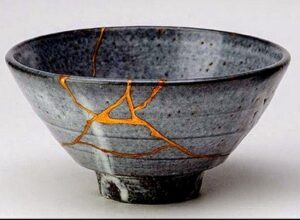 In “The Unknown Craftsman,” Japanese art critic Soetsu Yanagi writes, “We, in our own human imperfections, are repelled by the perfect, since everything is apparent from the start and there is no suggestion of the infinite.”
In “The Unknown Craftsman,” Japanese art critic Soetsu Yanagi writes, “We, in our own human imperfections, are repelled by the perfect, since everything is apparent from the start and there is no suggestion of the infinite.”
If you visited our home right now, the wall that leads upstairs to Jameson’s room, bears a trail of small fingerprints. Those who know my constant search for perfection in all things (read this as ‘anal retentive’) will also know that over the last few years Katelyn and I have livingly restored a beautiful old farmhouse (over 130 years old!) into a home we cherish. So, I am always looking to improve on the improved! When I would see an imperfection such as new fingerprints, it used to signal another to-do on my list: ‘Clean or paint those fingerprints off this wall.’ I would murmur to myself, again and again. But lately, rather than sigh over the lack of a pristine home, I’ve been learning to embrace wabi sabi, the Japanese art of appreciating the beauty in the naturally imperfect world. I have turned those fingerprints to be removed into marks that remind me of the beauty and wonderful gift of my new son, and that I am a dad, rather than something to be fixed. I no longer see those fingerprints as blemishes to be expunged from the wall on chores, but rather as the story of my son’s nightly treks up to bed where we enjoy some daddy-son time, holding one another as we rock in the glider in his room to hear the story of how Llama Llama gets his Red Pajamas!
Wabi sabi is an ancient aesthetic philosophy rooted in Zen Buddhism, particularly the very moving tea ceremony, a ritual of purity and simplicity in which masters prized irregularly shaped vessels are made, some with uneven glaze, cracks, and a perverse beauty in their deliberate imperfection. This Japanese philosophy celebrates beauty in what’s natural, flaws and all! The antique bowls above are prized because of (not in spite of) their drips and cracks and wounds.
I wonder…what if we learned to prize the drips and cracks that so often invade our messy lives? I wonder what would happen if we celebrated our brokenness as a path to growth and healing, and maybe, just maybe, a chrysalis into a new and better us?
At Saint Miriam we have always been reminded that ‘God’s light shines brightest through our cracks.’ I wonder if we can actual live into that belief and become what God has prepared?
See you Sunday!
P.S. What do the master Japanese artists fill in those cracks that occur in broken vessels…gold!

Persian artisans intentionally introduce an error into their works to signify that humans are inherently flawed; referred to as the Persian flaw, leaving the realm of the perfect to G-d.